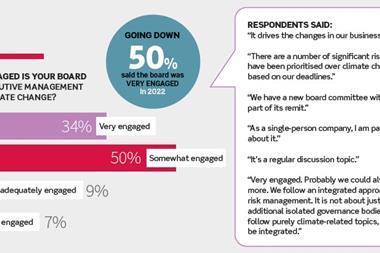New guide explores how organisations can pre-empt disorderly transition - here are the ten key lessons for risk managers
Reaching net zero is now critical, as governments and investors are increasingly committed to climate action.
Transition plans matter because action is required at both the strategic and operational levels for businesses to turn net zero commitments into reality.
But, increasingly, organisations including the World Economic Forum (WEF) are warning of a disorderly climate transition, where divergence on the direction of travel between countries and between business sectors is becoming a barrier to much-needed cooperation.
What does it mean for risk managers?
Risk professionals have a crucial role to plav.
They are at the front lines of businesses, whether they are navigating their organisations through the impact of physical climate risks such as rising sea levels, tackling Scope 3 emissions in their supply chains, or addressing intangible risks that are the result of reputational threats from greenwashing and from a new wave of regulations.
They are also well placed to bring synergy between insurers - large corporations which are making some of the most consequential climate commitments in the world today - and the businesses and organisations they steer as risk professionals.
What next? - Learning from research
Airmic and KPMG have collaborated on research to better understand the role of risk professionals in the climate transition today, the challenges and opportunities they face, and the issues each of their sectors are up against.
The ’De-risking the climate transition’ report is a culmination of findings from a survey of Airmic members and a roundtable comprising members of Airmic’s Climate Special Interest Group.
Here are the top ten key findings for risk managers:
- Airmic members are important insurance buyers. The estimated total annual insurance spend in 2022 for the organisations that they represent was £14.5 billion.
- 53% of respondents lack clarity about the budgets their organisations have set for their transition plans. In line with good practice, the transition plans of organisations should describe the supporting financial plans, budgets and related financial targets, such as the amount of capital and other expenditures supporting their decarbonisation strategy.
- One of the key challenges faced by risk professionals today as part of the climate transition lies in accurately measuring the Scope 3 emissions of their organisations - emissions that are the result of activities from the organisation’s value chain. At times, they have had to rely on low-quality data from their supply chain partners or have had no option but to make estimations based on third-party sources such as industry averages.
- Airmic members are calling for more consistency on the climate-related questions asked by underwriters as part of their underwriting submissions to insurers.
- Concerns over reputational risks trump all other climate-related insurance gaps for organisations.
- There is a sense from the roundtables run by Airmic that the onslaught of climate regulations today could have the perverse effect of leading to less disclosure and more green hushing.
- While the anti-ESG movement is predominantly still a US phenomenon, pension fund investments are among the most affected by this stance. The organisations of some Airmic members with sustainability products in some of the US states that have passed anti-ESG legislation are faced with a commercial challenge.
- Risk professionals are looking to insurers, brokers and consultants to help with data and project management, reporting and modelling - for the purpose of compiling the Task Force on Climate-related Financial Disclosures (TCFD), among other requirements.
- The voice of the customer is becoming more consequential in the insurance industry’s climate transition. Airmic members are increasingly including references to ESG priorities and actions in their insurance renewal presentations. Where their organisation has a captive insurance company, it is likely to connect with the parent on ESG. Some of their captives have an ESG framework and they too formally assess ESG performance.
- Over 40% of respondents say they consider the positions of insurers and brokers on ESG issues, when considering whom they will use.
Blog: Airmic Conference 2023 from Manchester
- 1
- 2
- 3
- 4
- 5
- 6
- 7
- 8
 Currently reading
Currently readingAirmic 2023: De-risking the climate transition
- 9
- 10
- 11
- 12































No comments yet